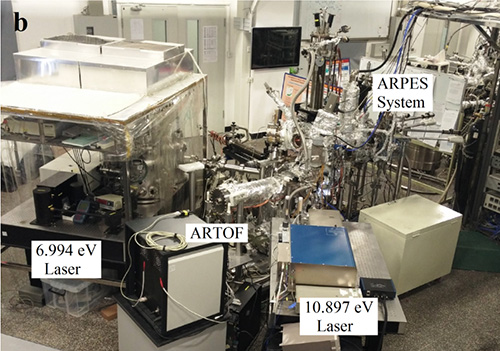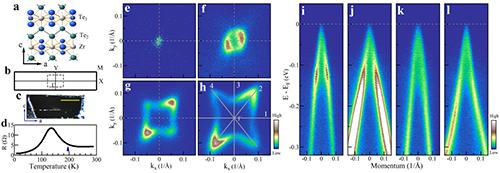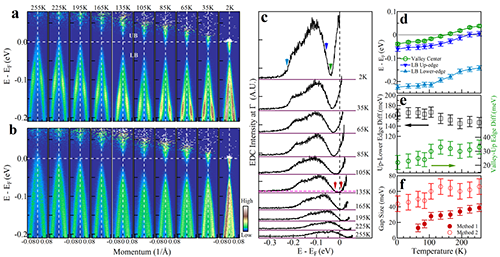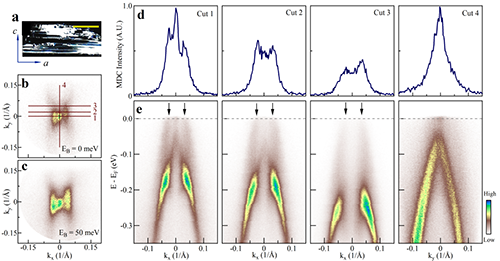Electronic evidence of temperature-induced Lifshitz transition and topological nature in ZrTe5
Date:23-06-2017 Print
The transition metal pentatellurides like ZrTe5 and HfTe5 have attracted considerable interest since the last 70s, because they exhibit unusual transport properties characterized by a strong resistivity peak at ~135K accompanied by a sign reversal of the Hall coefficient and thermopower across the peak temperature. The origin of such transport property anomalies has been a subject of a long-time debate but remains unclear. Recently, it was predicted that single-layer ZrTe5 is a two-dimensional and large bulk gap topological insulator, while bulk ZrTe5 may host a possibility of realizing a temperature-driven topological phase transition between the weak and strong topological insulators. Many experimental results have been reported to determine the topological nature of ZrTe5, but it remains controversial.
By using a newly developed & latest-generation angle resolved photoemission spectroscopy (ARPES) system equipped with the 6.994 eV vacuum ultraviolet laser and the time-of-flight electron energy analyser (ARToF 10K by Scienta Omicron), Ph. D students Yan Zhang, Chenlu Wang, Aiji Liang, Jianwei Huang and staffer Li Yu, systematically studied the electronic structure of ZrTe5 and its temperature evolution. The work is led by Prof. Guodong Liu and Prof. X. J. Zhou, in theoretical collaboration with Simin Nie and Hongming Weng of Prof. Zhong Fang and Xi Dai’s group. The samples are provided by Lingxiao Zhao in Prof. Genfu Chen’s group.
The researchers acquired high quantity Fermi surface and band structure in ZrTe5. They found that the overall electronic structure exhibits a marked temperature dependence that shifts down with decreasing temperature. This results in an electronic state evolution from a p-type semimetal with a hole-like Fermi pocket at high temperature above 135K, to a semiconductor around 135K where its resistivity shows a peak, to an n-type semimetal with an electron-like Fermi pocket at low temperature. These results constitute direct electronic evidence of a temperature-induced Lifshitz transition in ZrTe5, which provide a natural explanation on the underlying origin of the resistivity anomaly and the sign reversal of carrier. In addition, they observed quasi-one-dimensional electronic features that may be associated with the edge states of ZrTe5. Such an observation, together with the persistence of bandgap opening, absence of Dirac surface states and no topological phase transition over the entire temperature range they measured, indicates that ZrTe5 is a weak topological insulator.
This study entitled “Electronic evidence of temperature-induced Lifshitz transition and topological nature in ZrTe5” was published on Nature Communications.
The study was supported by the National Science Foundation of China, the 973 project of the Ministry of Science and Technology of China and the Strategic Priority Research Program (B) of the Chinese Academy of Sciences.
 |
| Fig. 1 Time-of- flight ARPES system (Image by Institute of Physics) |
 |
| Fig. 2 Fermi surface and band structure of ZrTe5measured at 195K (Image by Institute of Physics) |
 |
| Fig. 3 Temperature evolution of the band structure in ZrTe5(Image by Institute of Physics) |
 |
| Fig. 4 Temperature induced Lifshitz transition in ZrTe5(Image by Institute of Physics) |
 |
| Fig. 5 Observation of weak topological insulator feature in some ZrTe5samples (Image by Institute of Physics) |
Contact:
Institute of Physics
Guodong Liu
Email:gdliu_arpes@iphy.ac.cn
or
Xingjiang Zhou
Email:xjzhou@iphy.ac.cn
Key word:
ZrTe5, Lifshitz transition, weak topological insulator, angle resolved photoemission spectroscopy
Abstract:
A high-resolution laser-based angle-resolved photoemission study of ZrTe5 reveals a temperature-induced Lifshitz transition and one dimensional-like electronic features. It provides a natural understanding on underlying origin of the transport anomaly in ZrTe5, and indicates that ZrTe5 is a weak topological insulator.


